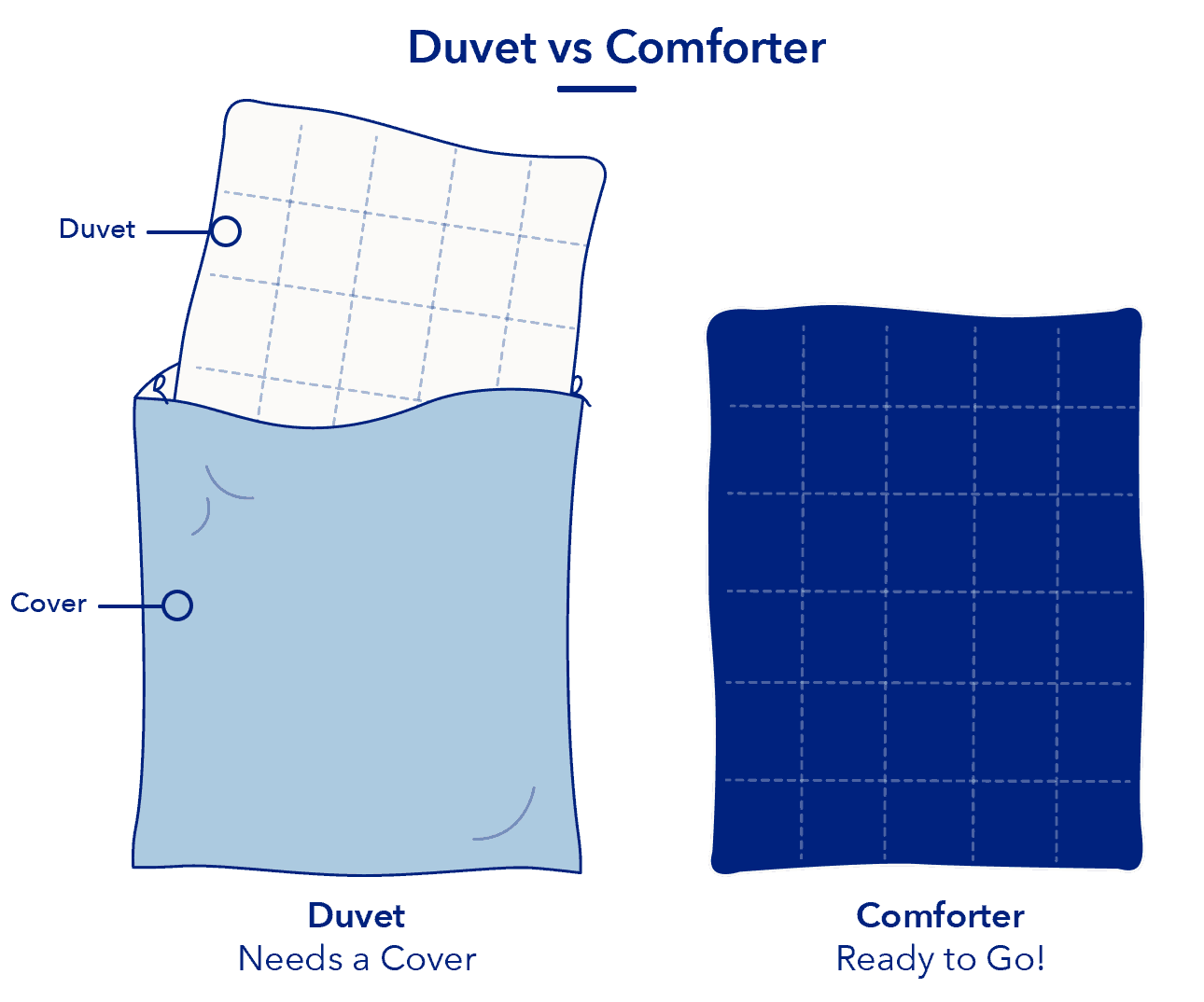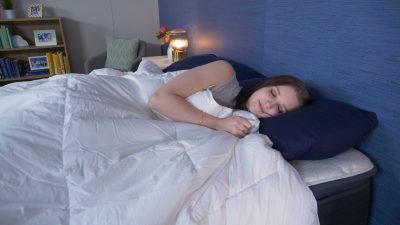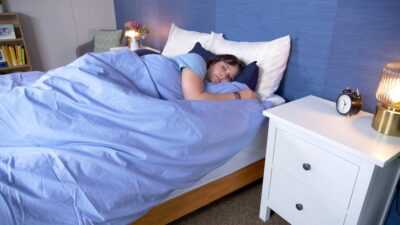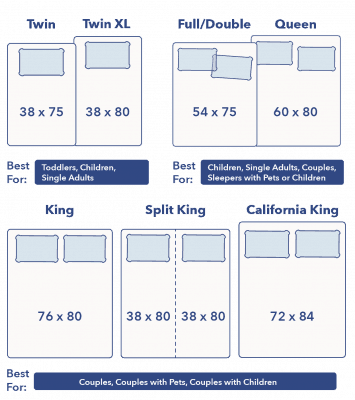I know you’ve likely heard the words “duvet” and “comforter” before, and you probably even have a loose idea of what each of them mean. But if you’re here, you’re looking for specifics. Trust me, you’re not alone.
Many people don’t actually know the difference between the two bedding essentials. I can not only tell you the major and subtle differences between a duvet and comforter, but also give you some advice on which one would work better for you.
Duvet vs Comforter: Comparison Video
Let’s get to the nitty gritty. What’s the actual difference between the two? Which one should you buy?
If you’re not much of a reader and would rather check out the video explainer, watch me break down the differences between these two sleep essentials here. If you’re more of a reader, keep scrolling to get to the meat of the article.
Duvet vs Comforter: What’s The Main Difference?
I like to think of duvets and comforters as similar to icing on top of a cake — the foundation (your bed) is already there. Your sheets and pillows are there. Now you just need to finish it off with your ideal flavor. Duvets and comforters are the heavier “quilts” that keep you warm while you sleep.
Both are usually filled with either natural or synthetic materials, including cotton, polyester, wool, feathers, or down on the inside.
The biggest difference between the two is that while a comforter is a stand-alone product, a duvet contains two separate pieces: the insert and the cover.
Most of the time when people hear the word “duvet” they immediately think of the duvet cover. You may also hear the words “duvet insert” and “fill” used interchangeably. Keep in mind that the duvet cover and the duvet insert are usually sold separately.
Similar to how you would put a pillow inside a pillow case, the duvet insert fits inside the duvet cover snug like a glove. A comforter does not have a separate cover. It is a stand-alone piece of bedding.

As you can see from the above graphic, a duvet insert is designed to go inside a duvet cover, however, a comforter is ready to go for use immediately out of the packaging. Comforters typically include some type of quilted pattern, and tend to be more thick and fluffy compared to a duvet cover (without the insert). A duvet cover is like an empty case ready to be filled with your ideal insert.
Duvet covers are usually able to stretch more than a comforter depending on the size of the insert, which may allow the duvet to expand and be more insulating. Keep in mind that duvet covers and duvet inserts don’t usually come together and, most of the time, need to be purchased separately.
While that may initially seem inconvenient, there are advantages and disadvantages to using either duvets and comforters.

Duvet vs Comforter: Pros And Cons
Let’s find out what some advantages and disadvantages are for both comforters and duvets and compare them side-by-side.
Comforter Advantages and Disadvantages
| Advantages | Disadvantages |
|
|
Comforters are great for sleepers who want an easier purchasing experience. Often, they can be bought together with matching pillowcases and sheets, which is a great option for those who don’t want to spend time matching different bedding accessories and patterns. This option is also suitable for those looking for a “catalog” bedroom aesthetic.
For these reasons, buying a comforter can be the more affordable option. In addition to this, comforters tend to have a consistent fill throughout, and are easy to layer with other bedding accessories.
On the other hand, some sleepers may like the versatility offered by changing the insert of a duvet to a different material. This is especially relevant for hot sleepers, who may want a lighter fill in cooler months.
Comforters lean big and bulky and can be difficult to wash at home, which can present a problem in some living situations.
If you’re sold on buying a new comforter, then I suggest you check out our picks of the best comforters to help you in your search!
Duvet Advantages and Disadvantages
Advantages | Disadvantages |
|
|
Duvets are great for people who prefer the option to customize mix-and-match pieces and those who like to change the look and feel of their space often (and easily). Many people prefer to change their duvet inserts during the warmer and colder months.
Since you can consistently change the insert and cover, many people think you can get more longevity out of a duvet as both the cover and the insert are easily replaceable and washing them, as well as storing them, is a breeze since they are less bulky compared to comforters.
Some duvet owners also actually sleep without a top sheet, which is called “sleeping European style.” Some brands will also sometimes substitute top sheets for duvet covers in select sheet sets. However, since duvet covers and duvet inserts are usually sold separately, that can be more pricey compared to comforters that, again, tend to be sold in a bundle.
If you’ve never placed a duvet insert in a duvet cover, it can be time consuming and it can take some practice to learn how to truly perfect it. When you are putting your insert inside the duvet cover, you want to ensure that the insert is evenly distributed so that there is uniformity in how the fill spreads out.
Are you set on buying a new duvet? We suggest that you check out our list of five of the best duvet covers.

Cleaning A Comforter
I suggest that you always follow the proper care instructions listed on the tag of your brand new comforter. Since comforters are thick and bulky, they can be hard to wash and dry. Some comforters may not even fit inside your washing machine at your home so you may have to head to a local laundromat or get it professionally cleaned.
Cleaning A Duvet
Duvets are easier to clean because you can separate the duvet insert and duvet cover. When you are ready to wash your duvet, you want to make sure that you separate the duvet insert and duvet cover and throw them both into your washing machine. At this point, you want to ensure you are following the proper care instructions that are listed on the tag. Since the duvet cover “protects” the duvet insert, you won’t need to wash the insert as frequently as you might the cover.
Which Size Should You Buy?
Once you’ve decided whether you want to buy either a comforter or a duvet, then you need to decide on what size. Mattress sizes can range from twin all the way up to Alaskan King. Luckily, duvets and comforters are available in all sizes so it will be a breeze to find one that matches your desired look and fits your mattress.

Duvet vs Comforter: Materials Used
Luckily for you, both duvets and comforters are made with the same type of materials: either natural, synthetic, or even a combination of both. Cotton and down are by far some of the more popular materials used in both duvets and comforters.
Natural materials, including cotton, silk, down, and feathers are known both for feeling luxurious and lasting a long time. If you are environmentally-conscious, then natural materials are the best option for you. Natural products also may be a stronger option for someone who suffers from allergies.
Synthetic materials, including nylon, polyester, and microfiber are popular because they are more affordable compared to their natural counterparts.
A duvet would allow you to swap out materials easily and you can decide whether you want one specific material for the duvet cover and then choose a different type of material to use for the duvet insert. Unlike a duvet, you will only be able to buy a comforter made with one specific type of material.
Duvet vs Comforter: Price Comparison
Deciding which bedding will work best for you and your family can be a tough decision. One of the biggest factors affecting that decision is your budget.
It’s worth noting that even though duvets and comforters tend to fall within a similar price range, it ultimately comes down to what materials the bedding is made with. Any bedding essentials that are made with natural and organic materials, such as down, silk, pure cotton and feathers, are going to be more pricey than those made with synthetic materials like polyester and microfiber.
To help give you a clear picture of the price breakdown between the two bedding options, let’s look at a few retail brands and see how their prices compare. Keep in mind that prices vary by size, and I used queen-size as the basic measurement for the below price ranges.
Average Comforter Set Price Breakdowns | Average Duvet Price Breakdowns |
|
Amazon: $30 – $80 |
Amazon: $25 – $85 |
|
Target: $50 – $150 |
Target: $30 – $160 |
|
Macy’s: $100 – $300 |
Macy’s: $80 – $350 |
|
Pottery Barn: $150 – $300 |
Pottery Barn: $70 – $200 |
***All of the above brands sell their duvet covers separate from duvet inserts. These brands also sell duvet sets which include the duvet cover and shams.
As previously mentioned, most duvet covers do not always come with duvet inserts, and are often two separate purchases, so be prepared that will likely increase that price point as well. It’s important to note that many comforters do come in bedding sets which include sheets and pillowcases, which can be more economical. In the end, a comforter is likely the more inexpensive option between the two.
For budget-friendly shoppers, the first place most of us look to find affordable bedding materials is the holy-grail of online shopping, Amazon. Most comforter sets that are made with either microfiber or cotton will cost you around $30 to $80. If you’re looking for a comforter made with feathers or down, then those will cost you a little bit more money at around $100 to $150 and up.
Typically, more widely-known brands sell their comforter sets between $100 to $300, however, these brands offer deals on their bedding essentials off and on throughout the year.
Again, you can skip the headache of diving into Amazon reviews and Google searches, and instead check out our roundup of the best comforters out right now to find the best option.
Duvet vs Comforter: Which Is The Best Option For You?
Ultimately, it is up to you to decide which option is right for you and your family. However, if you want something you can buy quickly with minimal setup and you prefer simplicity, then I suggest shopping for a comforter. That way all you have to do is head to your local store and buy a “bed-in-a-bag.”
If you like to mix and match bedding accessories or want a fabric you can switch out easily, then I suggest you shop for a duvet.
Duvet vs Comforter: FAQs
Can I use my comforter as a duvet insert?
Yes! Even though a duvet insert is made specifically to be paired with a duvet cover, you could technically put any type of bedding, including a quilt, comforter, or blanket inside your duvet insert if it fits.
Is a duvet the same thing as a quilt?
Even though duvets and quilts are both similar bedding essentials that are meant to keep us warm at night, they have stark differences as well. Quilts are more comparable to comforters as they are filled with two layers of fill and then are stitched together with a pattern. A duvet cover comes empty without the fill inside.
Can you use a duvet cover by itself?
Even though duvet covers are intended to be paired with a duvet insert, you can use a duvet cover by itself. The duvet cover wouldn’t be as thick or fluffy if you decide to use it without the insert, however, it could still be a good option to sleep with — especially during the warmer months.
Should I buy a duvet one size bigger than my mattress size?
Many brands suggest that you buy a duvet cover that is one size larger than the size of your mattress. This allows for the duvet to lay over more of the mattress and provide more comfort — especially if you are sharing the bed with a partner.
However, this rule-of-thumb doesn’t apply to duvet covers and duvet inserts. You should buy duvet inserts the same size of your duvet cover so the insert fits snug inside the cover and doesn’t bunch up or feel uneven.




























